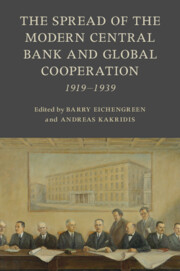Book contents
- The Spread of the Modern Central Bank and Global Cooperation
- Studies in Macroeconomic History
- The Spread of the Modern Central Bank and Global Cooperation
- Copyright page
- Contents
- Figures
- Tables
- Editors and Contributors
- Preface
- Part I General
- Part II Specific
- 5 Central Bank Policy under Foreign Control
- 6 Sneaking Nationalization
- 7 The Bank of Poland and Monetary Policy during the Interwar Period
- 8 From Banking Office to National Bank
- 9 ‘Nobody’s Child’
- 10 The Bulgarian National Bank, 1926–1935
- 11 Macroeconomic Policies and the New Central Bank in Turkey, 1929–1939
- 12 Latin American Experiments in Central Banking at the Onset of the Great Depression
- 13 Central Banks in the British Dominions in the Interwar Period
- 14 Central Banking and Colonial Control
- Index
- References
7 - The Bank of Poland and Monetary Policy during the Interwar Period
from Part II - Specific
Published online by Cambridge University Press: 02 November 2023
- The Spread of the Modern Central Bank and Global Cooperation
- Studies in Macroeconomic History
- The Spread of the Modern Central Bank and Global Cooperation
- Copyright page
- Contents
- Figures
- Tables
- Editors and Contributors
- Preface
- Part I General
- Part II Specific
- 5 Central Bank Policy under Foreign Control
- 6 Sneaking Nationalization
- 7 The Bank of Poland and Monetary Policy during the Interwar Period
- 8 From Banking Office to National Bank
- 9 ‘Nobody’s Child’
- 10 The Bulgarian National Bank, 1926–1935
- 11 Macroeconomic Policies and the New Central Bank in Turkey, 1929–1939
- 12 Latin American Experiments in Central Banking at the Onset of the Great Depression
- 13 Central Banks in the British Dominions in the Interwar Period
- 14 Central Banking and Colonial Control
- Index
- References
Summary
Like other developing countries, Poland based its interwar monetary policy on the gold exchange standard. Following a bout of hyperinflation , Władysław Grabski’s 1924 reform led to the establishment of the Bank of Poland. Early efforts to return to the gold standard, however, were not entirely successful. In 1925, an economic crisis weakened the zloty dramatically, before futher monterary reforms were introduced in 1927. Post-war monetary instability made Poland reluctant to abandon the gold standard after 1929 and foreign exchange controls were first introduced as late as 1936. The central banks reluctance to abandon the gold standard contributed to the depth and persistence of the Great Depression in Poland. The chapter thus reveals the challenges faced by a newly-formed country lacking adequate reserves and a financial track record to stabilise its currency; it also points to the path dependent nature of interwar monetary policy: the hyperinflation of 1919-23 and the crisis of 1925 created the belief that any easing of monetary policy would trigger an inflationary spiral. When the Great Depression struck, exchange rate stability trumped all other macroeconomic and financial policy objectives.
Keywords
- Type
- Chapter
- Information
- The Spread of the Modern Central Bank and Global Cooperation1919–1939, pp. 160 - 196Publisher: Cambridge University PressPrint publication year: 2023



